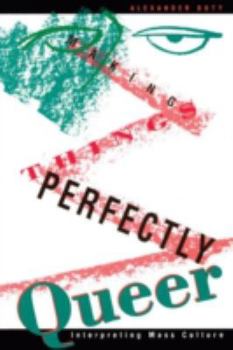Making Things Perfectly Queer: Interpreting Mass Culture
Select Format
Select Condition 
Book Overview
Doty argues that films, television, and other forms of mass culture consistently elicit a wide range of queer (sexually liminal) responses, and suggests an interpretive framework for understanding mass culture that stands as a corrective to many standard cultural approaches.
Format:Paperback
Language:English
ISBN:0816622450
ISBN13:9780816622450
Release Date:June 1993
Publisher:University of Minnesota Press
Length:168 Pages
Weight:0.65 lbs.
Dimensions:0.5" x 8.8" x 5.9"
Customer Reviews
1 rating
Teaching us how to queer cultural artifacts...
Published by Thriftbooks.com User , 23 years ago
Doty's volume is very popular. Here he analyzes various forms of mass culture, from the Jack Benny radio program to the TV program "Laverne and Shirley" to demonstrate the existence of queer (non-heterosexually coded performance) narratives at the center of all of these cultural productions. For example, Doty argues that in popular TV shows such as "Alice," "I Love Lucy", "Laverne and Shirley", the show depends on narrating from the perpective of the women in the show. Doty argues that the plot complications almost always stem from some male interference with the pleasure of the narrator, from unwanted suitors to demanding male bosses. Because heterosocial interaction is coded from narrator's perspective as intrusive, Doty labels these plot narratives "lesbian." Thus a queer reading of these shows reveals homosocial, if not homosexual, relationships as the important character and plot elements that are defended. Then again, it is heterocentrism that defines queer as "homosexual behavior" in the first place, so why should queer studies accept that definition, when its intention is to undermine hetercentrism in the first place!Jack Benny on the other hand, displays a central character whose behaviors are semiotically coded "feminine." He frets, bites his lip, has a lack of aggressive sexual desire for women, a loose, bouncy walk, and a high-pitched nervous giggle, to mention but a few things. The narrative display a central tendency to displace Benny from situations of power and influence--not the least of which was Benny's self-deprecating humor. Doty reminds us that Benny's biographies are full of his contemporaries remarking on his feminine characteristics. In this case, a queer reading is produced by taking an ostensibly "straight" man and imbuing him thoroughly with clearly "female" characteristics, all of which adds up to a queer character, never fitting in with compulsory heterosexual and masculine traits.These are just two examples of how queer readings are produced in Doty's work. All in all, he aims to show that it is queerness, not straightness, that lies at the center of mass cultural production. Thus he argues for the overturning of heterocentricity as the dominant way of reading culture. A tall claim, no doubt, but one that is tantalizing nonetheless.






